
Highly Sensitive Vibration Monitor
27.01.2017
Highly Sensitive Vibration Monitor
On Thursday 26th January the Norwegian Navy safely disarmed a 500 pound (227 kg) anti-submarine bomb from 1944. The controlled explosion happened 2.71 km from ClampOn’s facilities.
We set up our portable Vibration Monitor on the ground floor at ClampOn to see if we could pick up the vibrations. And yes, we did. The explosion took place at 2.02pm and the graph below shows the signal at precisely the same time.
This demonstrates the sensitivity of the ClampOn Vibration Monitor – and that this instrument can be used for other applications than originally intended (i.e. monitoring vibration in subsea structures).
During the Second World War, the coast of Norway saw many bombing raids, one of which targeted Laksevåg, close to where ClampOn now has its facilities. Apparently, not all bombs detonated back then and recently they found this bomb while performing some subsea work.
The Norwegian Navy explains that detonating bombs in shallow water is the preferred method. “Detonations in shallow water are the least damaging to marine life,” explains Viggo Korsvik, Commander at the Norwegian Joint Headquarters, and adds “in this situation, most of the energy is directed upwards instead of creating shock waves in the water that ricochet between the surface and seabed”. (Information from local newspaper Bergens Tidende (bt.no).
Link to Bergens Tidende – article of the explotion.
Link to NRK – videopresentation of the explosion.








